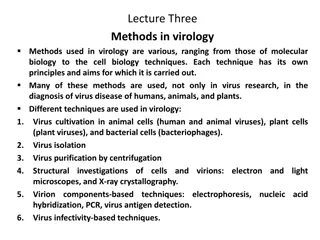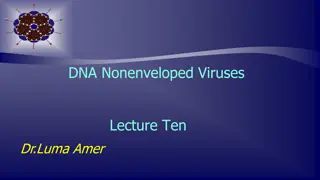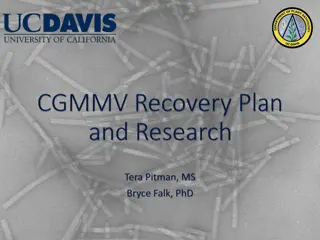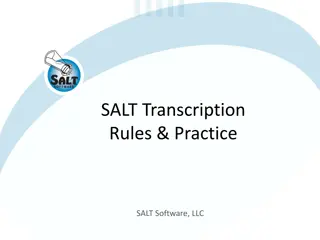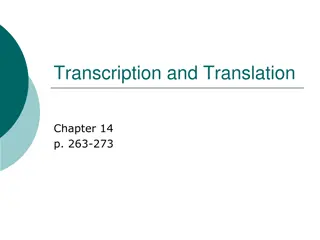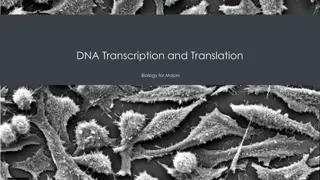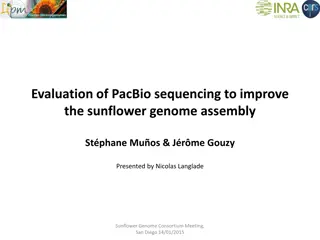Understanding Transcription and Translation of Virus Genome
The lecture covers the transcription and translation processes of virus genomes, including the Baltimore classification system, transcription control in eukaryotes, and the role of transcription factors in gene expression. It explores how different viruses replicate based on their genome type and method of replication, highlighting unique characteristics such as ambisense genomes. The discussion also delves into the control mechanisms involved in gene expression through enhancer sequences, promoters, terminators, and the significance of tissue-specific transcription factors in viral infections.
Download Presentation

Please find below an Image/Link to download the presentation.
The content on the website is provided AS IS for your information and personal use only. It may not be sold, licensed, or shared on other websites without obtaining consent from the author. Download presentation by click this link. If you encounter any issues during the download, it is possible that the publisher has removed the file from their server.
E N D
Presentation Transcript
Transcription and translation transport of Virus Genome Lecture 5 Dept. of Biology 2ndyear, 2021 Mustansiriyah University
Baltimore classification The Baltimore classification, developed by David Baltimore, is a virus classification system that groups viruses into classes, depending on their type of genome (DNA, RNA, single-stranded (ss), double- stranded (ds), etc..) and their method of replication.
Transcription of virus genome A nucleic acid strand that has the same sequence as mRNA is labelled (+) -a nucleic acid strand that has the sequence complementary to the mRNA is labelled ( ). The viruses with (+) RNA genomes (Classes IV and VI) have the same sequence as the virus mRNA. When these viruses infect cells, however, only the Class IV genomes can function as mRNA
there is a mixture of (+) and () polarity within the strand, in other words there are open reading frames (ORFs) in both directions. Genomes of this type are known as ambisense, a word derived from the Latin ambi, meaning on both sides (as in ambidextrous). Examples of ambisense genomes include the ssDNA genomes of the geminiviruses, which are plant viruses, and the ssRNA genomes of the arenaviruses, which are animal viruses and include the causative agent of Lassa fever.
How is transcription controlled in eukaryotes? The expression of a gene is controlled by various sequences in the DNA: enhancers sequences that contain binding sites for transcription factors, which affect the rate of transcription; a promoter the on switch; a terminator the sequence that causes the enzyme to stop transcription.
Transcription factors Transcription factors are proteins that bind specifically to promoter and enhancer sequences to control gene expression. Some viruses such as herpes simplex virus VP16 and (giant viruses) produce their own transcription factors. Some cell transcription factors can activate or repress transcription of viral genes. Tissue-specific transcription factors are required by some viruses, which probably explains why some viruses are tissue specific.
Capping transcripts (mRNA) The cap is a guanosine triphosphate joined to the end nucleotide by a 5 5 linkage, rather than the normal 5 3 linkage. A methyl group is added to the guanosine. The cell enzymes that carry out the capping activities are guanylyl transferases (they add the guanosine 5-triphosphate) and methyl transferases (they add the methyl groups). These enzymes are located in the nucleus and most of the viruses that carry out transcription in the nucleus, like the retroviruses, use the cell enzymes. Many of the viruses that replicate in the cytoplasm, however, encode their own capping and methylating enzymes; these viruses include the poxviruses, the reoviruses and the coronaviruses. Not all mRNAs are capped. Picornaviruses, for example, do not cap their mRNAs. Polyadenylation of transcripts A series of adenosine residues (a polyadenylate tail; poly(A) tail) is added to the 3 end of most primary transcripts of eukaryotes and their viruses. For instance, picornaviruses and rhabdoviruses have polyadenylated genomes. HIV-1, simian virus 40,
Transcriptases Transcriptase is a general term for an enzyme that carries out transcription. Viruses that replicate in the nucleus generally use a cell enzyme, while viruses that replicate in the cytoplasm encode their own. A DNA virus needs a DNA-dependent RNA polymerase to transcribe its genes into mRNA. Viruses that carry out transcription in the nucleus generally use the cell RNA polymerase II; these include the retroviruses, as well as many DNA viruses. DNA viruses that replicate in the cytoplasm use a virus-encoded enzyme because there is no appropriate cell enzyme in the cytoplasm. An RNA virus (apart from the retroviruses) needs an RNA-dependent RNA polymerase to transcribe its genes into mRNA. Each virus in Classes III, IV and V encodes its own enzyme, in spite of the fact that the cells of plants and some other eukaryotes encode ssRNA-dependent RNA polymerases. The retroviruses and the pararetroviruses perform reverse transcription using enzymes known as reverse transcriptases. These enzymes are RNA- dependent DNA polymerases, but they also have DNA-dependent DNA polymerase activity, as the process of reverse transcription involves synthesis of DNA using both RNA and DNA as the template.
Translation in eukaryotes A typical eukaryotic mRNA is monocistronic, i.e. it has one ORF from which one protein is translated. Sequences upstream and downstream of the ORF are not translated. Some large ORFs encode polyproteins, large proteins that are cleaved to form two or more functional proteins.
Transport in eukaryotic cells Virus molecules synthesized in the infected cell must also be transported to particular sites. Virus mRNAs are transported from the nucleus to the cytoplasm, and virus proteins may be transported to various locations, including the nucleus.







